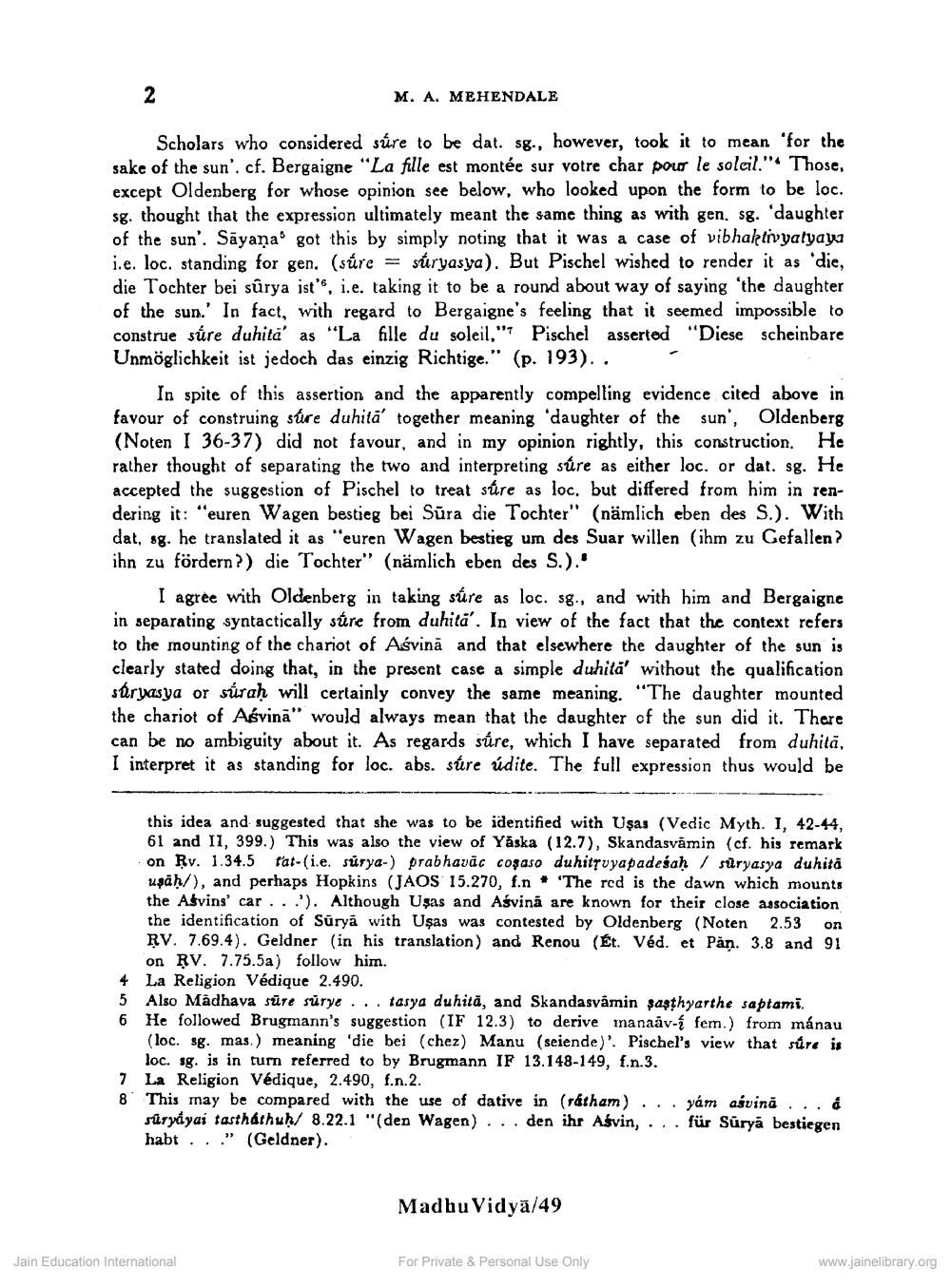________________
M. A. MEHENDALE
Scholars who considered súre to be dat. sg., however, took it to mean 'for the sake of the sun'. cf. Bergaigne "La fille est montée sur votre char pour le soleil.". Those, except Oldenberg for whose opinion see below, who looked upon the form to be loc. sg. thought that the expression ultimately meant the same thing as with gen. sg. 'daughter of the sun'. Sāyaṇa got this by simply noting that it was a case of vibhaktivyatyaya i.e. loc. standing for gen. (súre = súryasya). But Pischel wished to render it as 'die, die Tochter bei sûrya ist's, i.e. taking it to be a round about way of saying the daughter of the sun.' In fact, with regard to Bergaigne's feeling that it seemed impossible to construe súre duhita' as "La fille du soleil,"Pischel asserted "Diese scheinbare Unmöglichkeit ist jedoch das einzig Richtige." (p. 193). . -
In spite of this assertion and the apparently compelling evidence cited above in favour of construing sure duhita' together meaning daughter of the sun, Oldenberg (Noten I 36-37) did not favour, and in my opinion rightly, this construction. He rather thought of separating the two and interpreting súre as either loc. or dat. sg. He accepted the suggestion of Pischel to treat súre as loc, but differed from him in rendering it: "euren Wagen bestieg bei Sūra die Tochter" (nämlich eben des S.). With dat, sg. he translated it as "euren Wagen bestieg um des Suar willen (ihm zu Gefallen? ihn zu fördern?) die Tochter" (nämlich eben des S.).
I agree with Oldenberg in taking súre as loc. sg., and with him and Bergaigne in separating syntactically súre from duhita'. In view of the fact that the context refers to the mounting of the chariot of Asvina and that elsewhere the daughter of the sun is clearly stated doing that, in the present case a simple duhita' without the qualification súryasya or súraḥ will certainly convey the same meaning. "The daughter mounted the chariot of Asvinā" would always mean that the daughter of the sun did it. There can be no ambiguity about it. As regards súre, which I have separated from duhită, I interpret it as standing for loc. abs. súre údite. The full expression thus would be
this idea and suggested that she was to be identified with Uşas (Vedic Myth. I, 42-44, 61 and 11, 399.) This was also the view of Yaska (12.7), Skandasvamin (cf. his remark on Rv. 1.34.5 rat-(i.e. surya-) prabhavāc cosaso duhitruyapadeśaḥ / süryasya duhita upah/), and perhaps Hopkins (JAOS 15.270, f.n * 'The red is the dawn which mounts the Asvins' car...'). Although Usas and Asvină are known for their close association the identification of Surya with Uşas was contested by Oldenberg (Noten 2.53 on RV. 7.69.4). Geldner (in his translation) and Renou (Et. Véd. et Pån. 3.8 and 91
on RV. 7.75.5a) follow him. 4 La Religion Védique 2.490. 5 Also Madhava süre sürye . . . tasya duhită, and Skandasvamin sasthyarthe saptami.
He followed Brugmann's suggestion (IF 12.3) to derive manaāv-i fem.) from mánau (loc. sg. mas.) meaning "die bei (chez) Manu (seiende). Pischel's view that sure is
loc. sg. is in turn referred to by Brugmann IF 13.148-149, f.n.3. 7 La Religion Védique, 2.490, f.n.2. 8 This may be compared with the use of dative in (ratham)...yámasvină ...
sürydyai tasthathuḥ/ 8.22.1 "(den Wagen)... den ihr Asvin, ... für Sürya bestiegen habt..." (Geldner).
Madbu Vidyā/49
Jain Education International
For Private & Personal Use Only
www.jainelibrary.org




